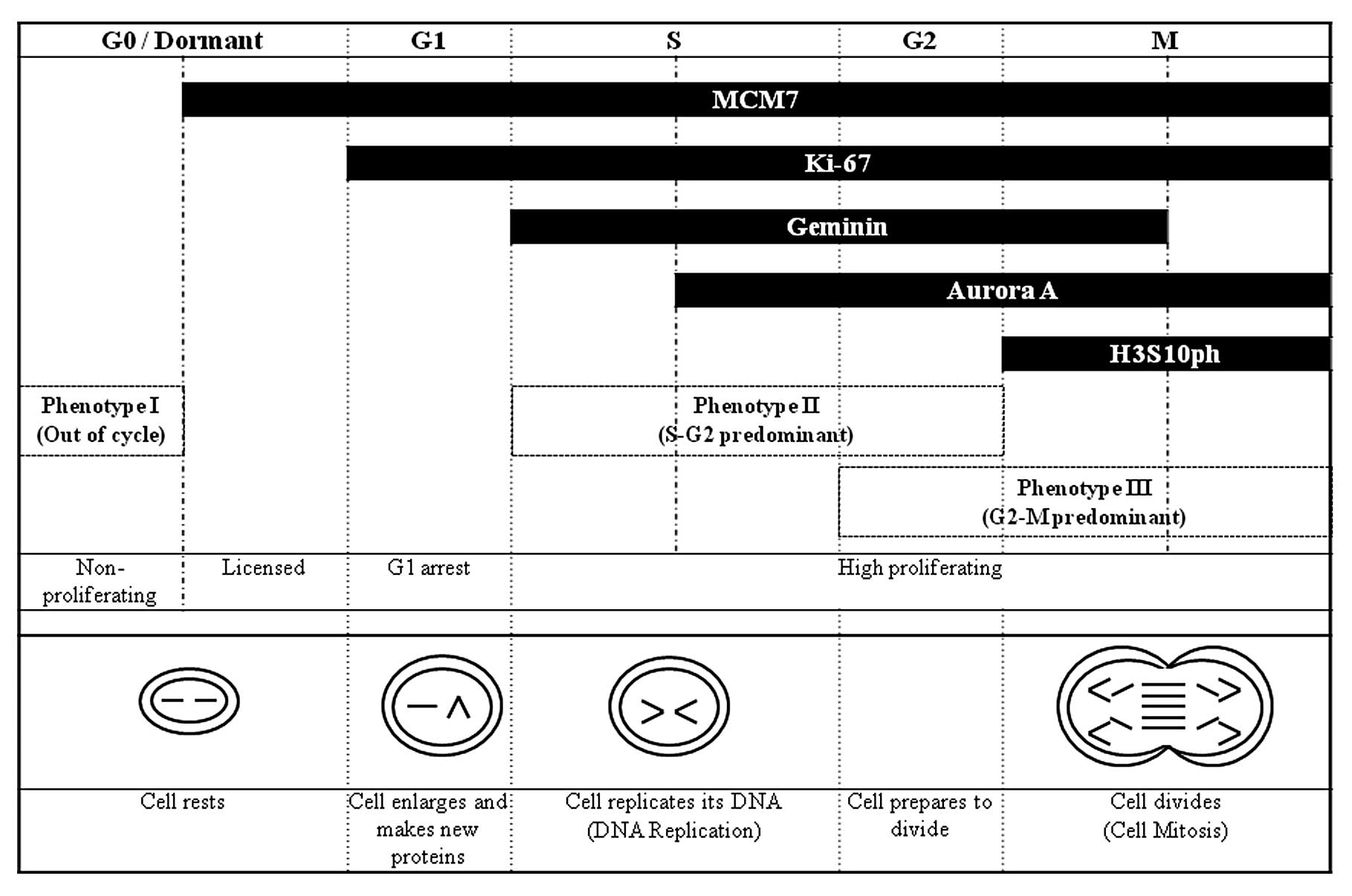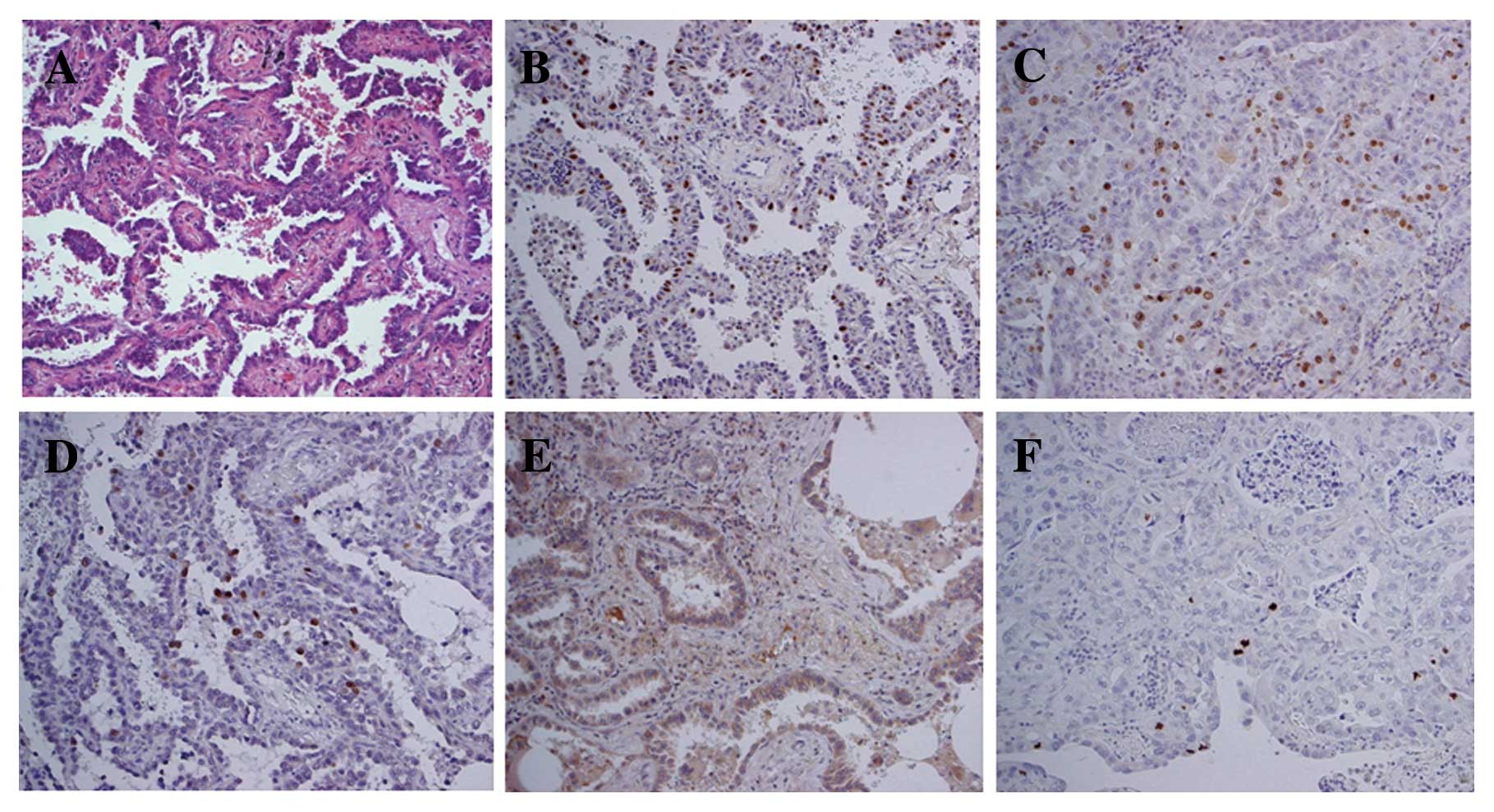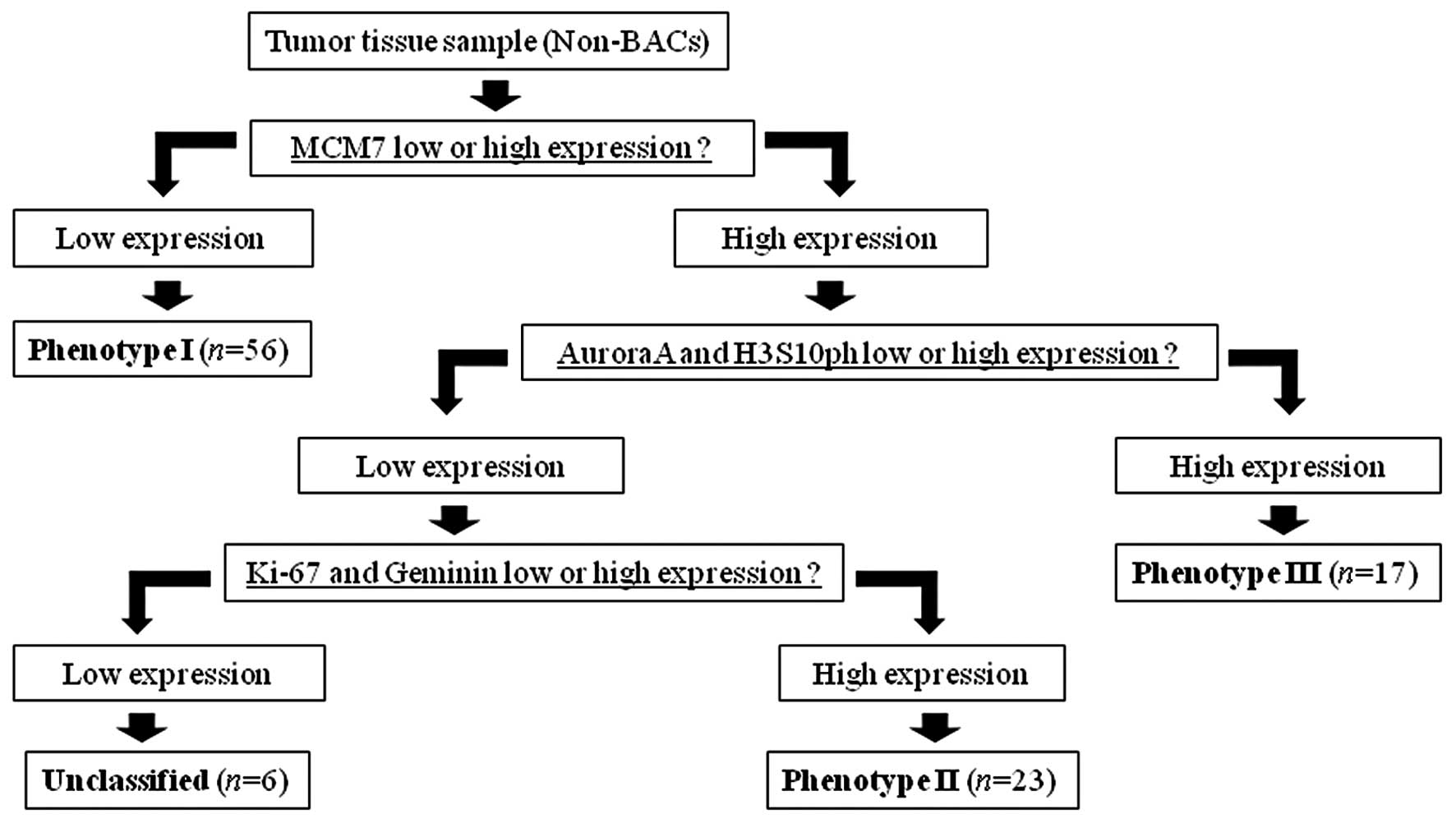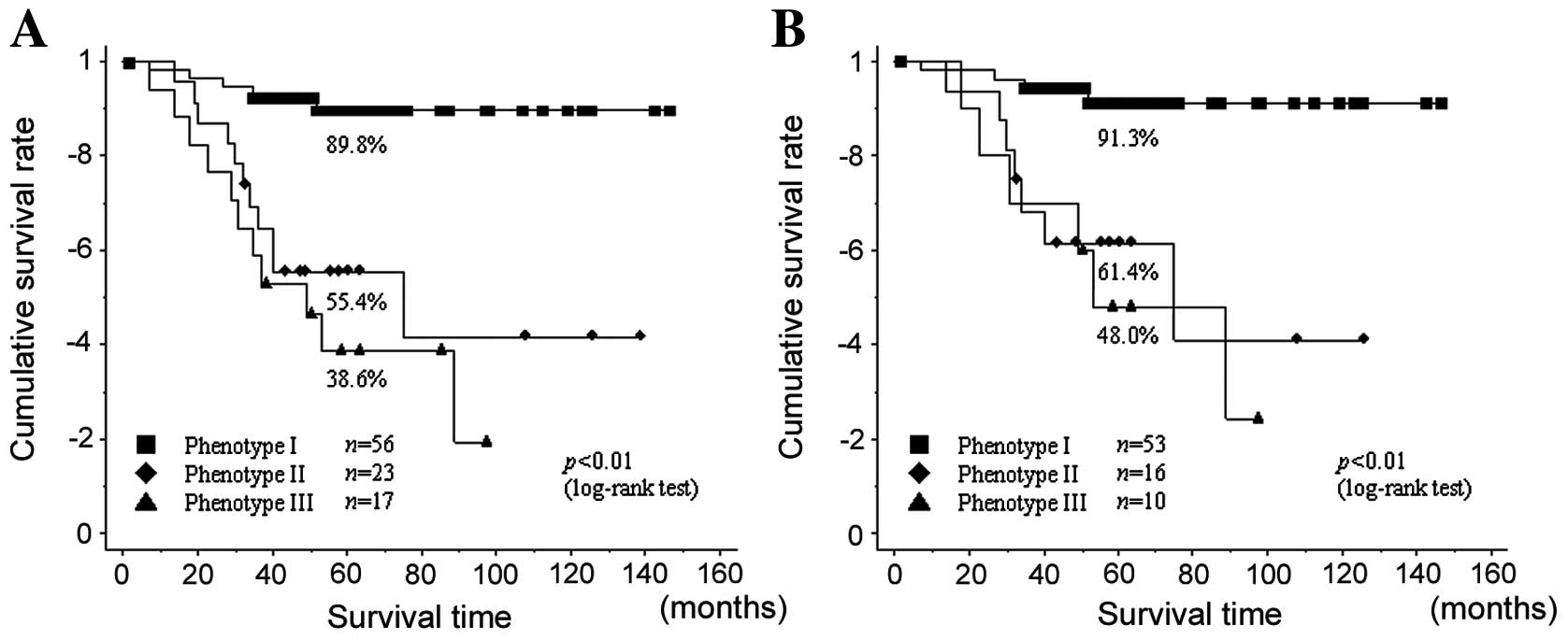|
1
|
Travis WD, Brambilla E, Muller-Hermelink
HK and Harris CC: World Health Organization Classification of
Tumors. Pathology and Genetics of Tumors of the Lung, Pleura,
Thymus and Heart. IARC Press; Lyon: pp. 12–44. 2004
|
|
2
|
Louis DN, Edgerton S, Thor AD and
Hedley-Whyte ET: Proliferating cell nuclear antigen and Ki-67
immunohistochemistry in brain tumors: a comparative study. Acta
Neuropathol. 81:675–679. 1991.
|
|
3
|
Mehdi SA, Etzell JE, Newman NB, Weidner N,
Kohman LJ and Graziano SL: Prognostic significance of Ki-67
immunostaining and symptoms in resected stage I and II non-small
cell lung cancer. Lung Cancer. 20:99–108. 1998.
|
|
4
|
Haga Y, Hiroshima K, Iyoda A, et al: Ki-67
expression and prognosis for smokers with resected stage I
non-small cell lung cancer. Ann Thorac Surg. 75:1727–1732.
2003.
|
|
5
|
Dudderidge TJ, Stoeber K, Loddo M,
Atkinson G, Fanshawe T, Griffiths DF and Williams GH: Mcm2,
Geminin, and Ki67 define proliferative state and are prognostic
markers in renal cell carcinoma. Clin Cancer Res. 11:2510–2517.
2005.
|
|
6
|
Vargas PA, Cheng Y, Barrett AW, Craig GT
and Speight PM: Expression of Mcm-2, Ki-67 and geminin in benign
and malignant salivary gland tumours. J Oral Pathol Med.
37:309–318. 2008.
|
|
7
|
Fujioka S, Shomori K, Nishihara K, et al:
Expression of minichromosome maintenance 7 (MCM7) in small lung
adenocarcinomas (pT1): prognostic implication. Lung Cancer.
65:223–229. 2009.
|
|
8
|
Hashimoto K, Araki K, Osaki M, Nakamura H,
Tomita K, Shimizu E and Ito H: MCM2 and Ki-67 expression in human
lung adenocarcinoma: prognostic implications. Pathobiology.
71:193–200. 2004.
|
|
9
|
Kulkarni AA, Loddo M, Leo E, et al: DNA
replication licensing factors and aurora kinases are linked to
aneuploidy and clinical outcome in epithelial ovarian carcinoma.
Clin Cancer Res. 13:6153–6161. 2007.
|
|
10
|
Loddo M, Kingsbury SR, Rashid M, et al:
Cell-cycle-phase progression analysis identifies unique phenotypes
of major prognostic and predictive significance in breast cancer.
Br J Cancer. 100:959–970. 2009.
|
|
11
|
Kayes OJ, Loddo M, Patel N, et al: DNA
replication licensing factors and aneuploidy are linked to tumor
cell cycle state and clinical outcome in penile carcinoma. Clin
Cancer Res. 15:7335–7344. 2009.
|
|
12
|
Nishitani H and Lygerou Z: Control of DNA
replication licensing in a cell cycle. Genes Cells. 7:523–534.
2002.
|
|
13
|
Pitulescu M, Kessel M and Luo L: The
regulation of embryonic patterning and DNA replication by geminin.
Cell Mol Life Sci. 62:1425–1433. 2005.
|
|
14
|
Tamura T, Shomori K, Haruki T, et al:
Minichromosome maintenance-7 and geminin are reliable prognostic
markers in patients with oral squamous cell carcinoma:
immunohistochemical study. J Oral Pathol Med. 39:328–334. 2010.
|
|
15
|
Torres-Rendon A, Roy S, Craig GT and
Speight PM: Expression of Mcm2, geminin and Ki67 in normal oral
mucosa, oral epithelial dysplasias and their corresponding
squamous-cell carcinomas. Br J Cancer. 100:1128–1134. 2009.
|
|
16
|
Nishihara K, Shomort K, Fujioka S, et al:
Minichromosome maintenance protein 7 in colorectal cancer:
implication of prognostic significance. Int J Oncol. 33:245–251.
2008.
|
|
17
|
Nishihara K, Shomori K, Tamura T, Fujioka
S, Ogawa T and Ito H: Immunohistochemical expression of geminin in
colorectal cancer: implication of prognostic significance. Oncol
Rep. 21:1189–1195. 2009.
|
|
18
|
Tokuyasu N, Shomori K, Nishihara K, et al:
Minichromosome maintenance 2 (MCM2) immunoreactivity in stage III
human gastric carcinoma: clinicopathological significance. Gastric
Cancer. 11:37–46. 2008.
|
|
19
|
Nigg EA: Mitotic kinases as regulators of
cell division and its checkpoints. Nat Rev Mol Cell Biol. 2:21–32.
2001.
|
|
20
|
Crosio C, Fimia GM, Loury R, et al:
Mitotic phosphorylation of histone H3: spatio-temporal regulation
by mammalian Aurora kinases. Mol Cell Biol. 22:874–885. 2002.
|
|
21
|
Bischoff JR, Anderson L, Zhu Y, et al: A
homologue of Drosophila aurora kinase is oncogenic and
amplified in human colorectal cancers. EMBO J. 17:3052–3065.
1998.
|
|
22
|
Jeng YM, Peng SY, Lin CY and Hsu HC:
Overexpression and amplification of Aurora-A in hepatocellular
carcinoma. Clin Cancer Res. 10:2065–2071. 2004.
|
|
23
|
Kurahashi T, Miyake H, Hara I and Fujisawa
M: Significance of Aurora-A expression in renal cell carcinoma.
Urol Oncol. 25:128–133. 2007.
|
|
24
|
Lam AK, Ong K and Ho YH: Aurora kinase
expression in colorectal adenocarcinoma: correlations with
clinicopathological features, p16 expression, and telomerase
activity. Hum Pathol. 39:599–604. 2008.
|
|
25
|
Ogawa E, Takenaka K, Katakura H, et al:
Perimembrane Aurora-A expression is a significant prognostic factor
in correlation with proliferative activity in non-small cell lung
cancer (NSCLC). Ann Surg Oncol. 15:547–554. 2008.
|
|
26
|
Shang X, Burlingame SM, Okcu MF, et al:
Aurora A is a negative prognostic factor and a new therapeutic
target in human neuroblastoma. Mol Cancer Ther. 8:2461–2469.
2009.
|
|
27
|
Tanaka E, Hashimoto Y, Ito T, et al: The
clinical significance of Aurora-A/STK15/BTAK expression in human
esophageal squamous cell carcinoma. Clin Cancer Res. 11:1827–1834.
2005.
|
|
28
|
Zhang XH, Rao M, Loprieato JA, et al:
Aurora A, Aurora B and survivin are novel targets of
transcriptional regulation by histone deacetylase inhibitors in
non-small cell lung cancer. Cancer Biol Ther. 7:1390–1399.
2008.
|
|
29
|
Williams GH and Stoeber K: Cell cycle
markers in clinical oncology. Curr Opin Cell Biol. 19:672–679.
2007.
|
|
30
|
Sobin LH: UICC International Union Against
Cancer: TNM classification of malignant tumours. 6th edition. John
Wiley & Sons; New York: 2002
|
|
31
|
Suzuki K, Yokose T, Yoshida J, Nishimura
M, Takahashi K, Nagai K and Nishiwaki Y: Prognostic significance of
the size of central fibrosis in peripheral adenocarcinoma of the
lung. Ann Thorac Surg. 69:893–897. 2000.
|
|
32
|
Stoeber K, Tlsty TD, Happerfield L, Thomas
GA, Romanov S, Bobrow L, Williams ED and Williams GH: DNA
replication licensing and human cell proliferation. J Cell Sci.
114:2027–2041. 2001.
|
|
33
|
Blow JJ and Hodgson B: Replication
licensing - defining the proliferative state? Trends Cell Biol.
12:72–78. 2002.
|
|
34
|
Freeman A, Morris LS, Mills AD, Stoeber K,
Laskey RA, Williams GH and Coleman N: Minichromosome maintenance
proteins as biological markers of dysplasia and malignancy. Clin
Cancer Res. 5:2121–2132. 1999.
|
|
35
|
Gonzalez MA, Tachibana KK, Laskey RA and
Coleman N: Control of DNA replication and its potential clinical
exploitation. Nat Rev Cancer. 5:135–141. 2005.
|
|
36
|
Montanari M, Macaluso M, Cittadini A and
Giordano A: Role of geminin: from normal control of DNA replication
to cancer formation and progression? Cell Death Differ.
13:1052–1056. 2006.
|
|
37
|
Gonzalez MA, Tachibana KE, Chin SF, et al:
Geminin predicts adverse clinical outcome in breast cancer by
reflecting cell-cycle progression. J Pathol. 204:121–130. 2004.
|
|
38
|
Marumoto T, Zhang DW and Saya H: Aurora-A:
a guardian of poles. Nat Rev Cancer. 5:42–50. 2005.
|
|
39
|
Tong T, Zhong Y, Kong J, et al:
Overexpression of Aurora-A contributes to malignant development of
human esophageal squamous cell carcinoma. Clin Cancer Res.
10:7304–7310. 2004.
|
|
40
|
Royce ME, Xia WY, Sahin AA, et al:
STK15/Aurora-A expression in primary breast tumors is correlated
with nuclear grade but not with prognosis. Cancer. 100:12–19.
2004.
|
|
41
|
Johnson KR, Wang L, Miller MC III, et al:
5-Fluorouracil interferes with paclitaxel cytotoxicity against
human solid tumor cells. Clin Cancer Res. 3:1739–1745. 1997.
|


















